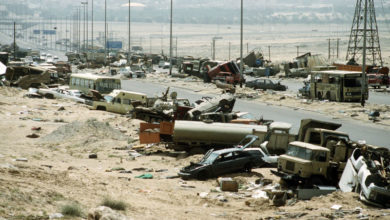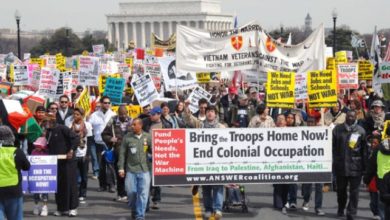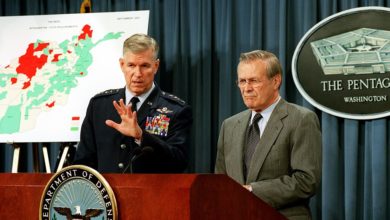In the weeks leading up to the November 2006 mid-term elections, the war in Iraq loomed large in polls and in media commentary. But despite the fact that a clear majority of people in the United States are against the war, there was no opportunity to choose a candidate from either of the big-business parties who reflected that sentiment.
 U.S. troops have been unable to set up a stable client government in Iraq. Photo: Wissam Al-Okaili/AFP/Getty Image |
The leaderships of both Democratic and Republican parties are in complete agreement over their desire to recolonize Iraq, despite tactical disagreements. Unfortunately for them, the Iraqi people’s deep-seated desire to regain control of their sovereignty has upset their plans. The indigenous resistance movement is inflicting increasingly unsustainable casualties on the U.S. occupation forces. The Pentagon is barely in control of Baghdad, with the fortress-like “green zone” the only secure sector in the city.
U.S. occupation yields death and destruction
For the Iraqi people, the occupation has been brutally harsh. According to an Oct. 11 report in the online British journal Lancet, 655,000 Iraqis —2.3 percent of the population—have been killed as a consequence of the U.S. war of “liberation.” Proportional to the population, that scale of killing would amount to 7 million people in the United States.
All indicators of the quality of life of a nation show that the U.S. occupation has increased the suffering and misery of the Iraqi people, on top of 13 years of U.S.-imposed sanctions before the 2003 invasion.
During the period when harsh economic sanctions were imposed on Iraq in 1990 until the U.S. invasion in 2003, Baghdad residences received 16 to 24 hours of electricity a day, according to a Nov. 2 Brookings Institute study. Today, more than three years after the invasion, Baghdad residences outside the green zone get 5.6 hours of electricity daily.
Water treatment before the invasion was 3 million cubic meters a day. By March 2006, the rate had dropped by more than half, to 1.3 million cubic meters a day.
A May 2 report released by UNICEF showed that 25 percent of Iraqi children between six months and five years old suffer from chronic or acute malnutrition, and that the situation has worsened since the U.S. invasion of Iraq.
Estimates of unemployment range from 25 to 40 percent.
Iraqi resistance widens
From the Pentagon’s standpoint, the occupation is becoming more and more of a quagmire. October 2006 was the fourth deadliest month for U.S. military personnel since the invasion, with 103 acknowledged deaths.
Rank-and-file U.S. soldiers are increasingly turning against their missions. A February 2006 Zogby International poll showed that 72 percent of U.S. troops serving in Iraq think that the United States should exit the country within the next year. More than one in four say the troops should leave immediately.
At the same time, the Iraqi resistance is averaging over 100 attacks a day on the occupation forces. In a sign of increased political strength and coordination, Iraqi resistance forces staged public military parades in the cities of Ramadi, Haditha, Bani Daher, Rawah and Haqlaniyah in late October. Some of those parades took place less than a mile from U.S. military bases.
Fallout amongst ruling-class thieves
While the war and occupation has been a murderous nightmare for the Iraqi people, it is also increasingly seen as an unmitigated failure for U.S. imperialism. The Bush administration had initially promised that the war would be over in a few weeks. They dreamed that the human and material resources of Iraq could then be plundered for imperialist profit.
Imperialist spokespeople like Donald Rumsfeld, Paul Wolfowitz and Richard Perle had also hoped that Iraq would be an example to the rest of the world when a nation dared to resist the U.S. empire. After the fall of Baghdad in April 2003, U.S. ambassador to the United Nations John Bolton said that Iran, Syria and North Korea should “draw the appropriate lesson from Iraq.”
The plan was to roll into Baghdad and install a pliant puppet regime that would share in the plunder and suppress the Iraqi people’s desire for self-determination. Any resources spent on rebuilding Iraq would be for the purpose of repairing the infrastructure destroyed by the war and the years of sanctions to facilitate the extraction, processing and exporting of oil to international markets.
But after three years and close to $400 billion spent on the occupation, this vision is in tatters. In the face of this potential defeat, the ruling class political establishment is increasingly turning against the most prominent architects of the Pentagon’s Iraq strategy.
Of course, the calls for a new strategy in Iraq have nothing to do with the misery inflicted on the Iraqi people, the horrors of Abu Ghraib or the massacres committed by U.S. troops in Fallujah, al-Haditha or Hamandiyah. It is because neither the imperialist geopolitical aims nor the economic goals have been accomplished.
A ‘lost year’?
A documentary aired in October by the PBS TV series Frontline, “The Lost Year,” argues that the current situation can be traced back to mistakes made by the civilian and military administrations during the first year of the occupation. The program blames poor planning, a lack of coordination between the Pentagon and the Civilian Provisional Authority headed by L. Paul Bremer and a flood of ill-trained and poorly vetted neoconservative operatives responsible for reconstituting Iraq according to their own colonial vision.
For example, the report points to the group of planners appointed to reorganize the entire Iraqi prison system. The team had no practical planning experience. In fact, all they had in common was they were fraternity members who had recently graduated together from the same college.
Of course, this kind of corruption and political patronage is not unique to Iraq. It is the typical reward for being on the “winning” side of an imperialist war. But the PBS exposé would not have been made if the occupation’s goals had been achieved and oil profits were flowing into the imperialist banks.
In a series of interviews, “The Lost Year” intentionally or unintentionally shows the racist attitude of the U.S. personnel who administered the occupation on a day-to-day basis.
In one interview, for example, Barbara Bodine, an ambassador with the Office of Humanitarian Assistance, tries to discredit the resistance movement by saying its origins could be found in the civil unrest and chaos that occurred in Baghdad after the collapse of the Iraqi state. She equates the growth of the resistance movement to a disease with its biological origin in those events.
This racist analogy for the heroic Iraqi people standing up to occupation, coming from a “humanitarian” ambassador supposedly more versed in the art of diplomacy, provides a useful insight into how the military and policy planners of U.S. imperialism view an occupied people.
Military power versus popular resistance
The Bush administration made the decision to invade Iraq in the first days after the 2000 elections. This fact has now been documented in a number of sources, like the memoirs of former treasury secretary Paul O’Neill.
U.S. imperialism focused its unparalleled arsenal of technological, economic, political and military resources in its quest for global domination: eye-in-the-sky satellites, the world’s most powerful military, political hegemony in the United Nations and command of international financial institutions like the International Monetary Fund.
 Baghdad residents cheer as U.S. troops take down checkpoints, Oct. 31. Photo: Reuters/Kareen Raheem |
The Pentagon put thousands of planners to work in preparing the invasion and the occupation. Think-tank experts prepared hundreds of scenarios and options. The big-business media spent thousands of hours of airtime and endless pages of newspapers and websites preparing the U.S. public for war—even before the Sept. 11 attacks. Diplomats cajoled willing and unwilling allies in capitals around the world.
On March 19, 2003, the culmination of these efforts led to the invasion of Iraq.
But like all empires before it, U.S. imperialist planners underestimated the power of the masses to resist. All the planning neglected the Iraqi people’s desire for sovereignty and control over their country and its resources.
The U.S. military cannot be defeated in the formal military sense—on the battlefield with tanks, planes and ships. But war is not just a military project. An army of soldiers with no material interest in victory—in this case, the subjugation of an entire people for the sake of oil profits—is no match for a resistance deeply rooted in the population and infused with the drive for national liberation.
It was a lesson that the Vietnamese liberation forces re-taught the Pentagon generals and imperialist politicians. It was the dream of the Bush gang to prove that lesson false.
The Iraqi people want an end to the occupation. That is evident as much in the daily acts of resistance as in polls conducted by the occupying regime itself.
At the same time, the U.S. public has increasingly turned against the war. Thousands of soldiers have died and tens of thousands have been seriously injured. While billions of dollars are spent on the war, social services are cut back and eliminated.
The problem facing the Bush administration and the new Democratic-controlled Congress is that the Pentagon cannot militarily defeat the resistance or insurgency in Iraq nor can it easily withdraw without potentially igniting other anti-U.S. insurrections in Egypt, Jordan and Saudi Arabia. Avoiding the perception of a military defeat has thus become a central objective for Pentagon policy makers and the imperialist establishment as a whole. This is somewhat of a repeat of a predicament that faced the Nixon administration when it assumed office in 1969.
Nixon and the military realized by late 1969 that victory in Vietnam, in the military sense, was impossible. Their new goal was to escape a catastrophic defeat. Thirty thousand additional U.S. soldiers and hundreds of thousands of Vietnamese died between 1969 and 1973 before the U.S. political establishment recognized that defeat was indeed impossible to avoid.






